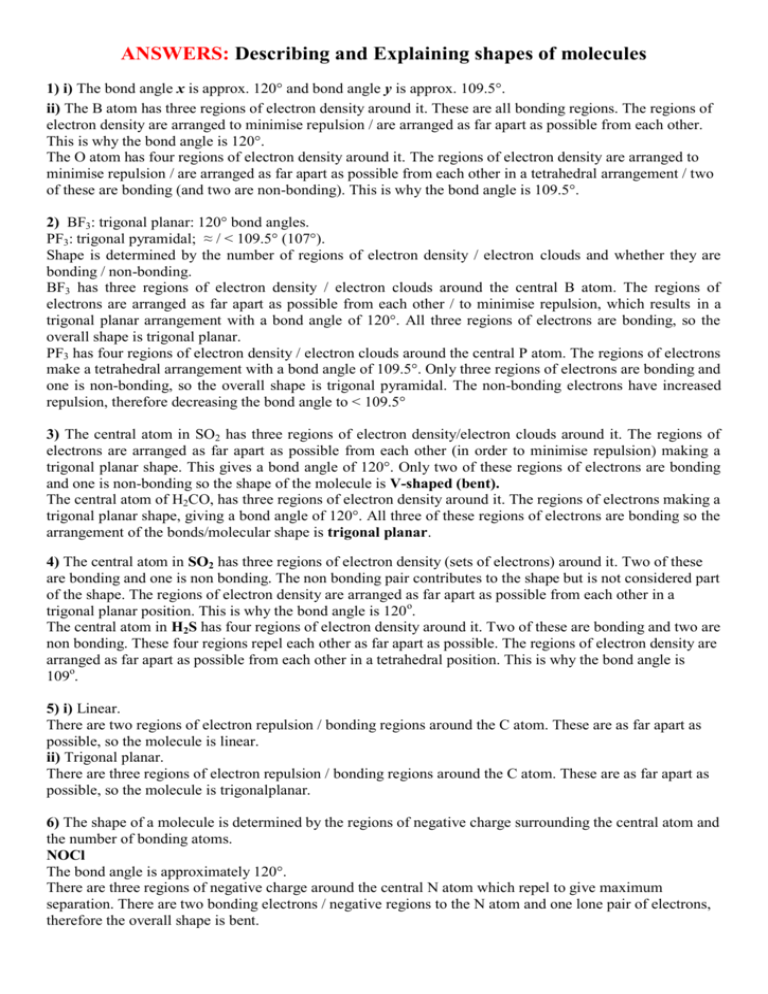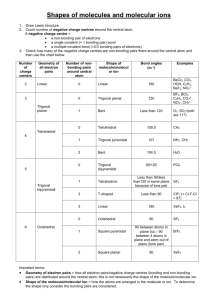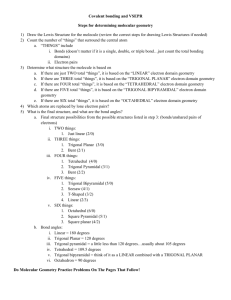ANSWERS: Describing and Explaining shapes of
advertisement

ANSWERS: Describing and Explaining shapes of molecules 1) i) The bond angle x is approx. 120° and bond angle y is approx. 109.5°. ii) The B atom has three regions of electron density around it. These are all bonding regions. The regions of electron density are arranged to minimise repulsion / are arranged as far apart as possible from each other. This is why the bond angle is 120°. The O atom has four regions of electron density around it. The regions of electron density are arranged to minimise repulsion / are arranged as far apart as possible from each other in a tetrahedral arrangement / two of these are bonding (and two are non-bonding). This is why the bond angle is 109.5°. 2) BF3: trigonal planar: 120° bond angles. PF3: trigonal pyramidal; ≈ / < 109.5° (107°). Shape is determined by the number of regions of electron density / electron clouds and whether they are bonding / non-bonding. BF3 has three regions of electron density / electron clouds around the central B atom. The regions of electrons are arranged as far apart as possible from each other / to minimise repulsion, which results in a trigonal planar arrangement with a bond angle of 120°. All three regions of electrons are bonding, so the overall shape is trigonal planar. PF3 has four regions of electron density / electron clouds around the central P atom. The regions of electrons make a tetrahedral arrangement with a bond angle of 109.5°. Only three regions of electrons are bonding and one is non-bonding, so the overall shape is trigonal pyramidal. The non-bonding electrons have increased repulsion, therefore decreasing the bond angle to < 109.5° 3) The central atom in SO2 has three regions of electron density/electron clouds around it. The regions of electrons are arranged as far apart as possible from each other (in order to minimise repulsion) making a trigonal planar shape. This gives a bond angle of 120°. Only two of these regions of electrons are bonding and one is non-bonding so the shape of the molecule is V-shaped (bent). The central atom of H2CO, has three regions of electron density around it. The regions of electrons making a trigonal planar shape, giving a bond angle of 120°. All three of these regions of electrons are bonding so the arrangement of the bonds/molecular shape is trigonal planar. 4) The central atom in SO2 has three regions of electron density (sets of electrons) around it. Two of these are bonding and one is non bonding. The non bonding pair contributes to the shape but is not considered part of the shape. The regions of electron density are arranged as far apart as possible from each other in a trigonal planar position. This is why the bond angle is 120 o. The central atom in H2S has four regions of electron density around it. Two of these are bonding and two are non bonding. These four regions repel each other as far apart as possible. The regions of electron density are arranged as far apart as possible from each other in a tetrahedral position. This is why the bond angle is 109o. 5) i) Linear. There are two regions of electron repulsion / bonding regions around the C atom. These are as far apart as possible, so the molecule is linear. ii) Trigonal planar. There are three regions of electron repulsion / bonding regions around the C atom. These are as far apart as possible, so the molecule is trigonalplanar. 6) The shape of a molecule is determined by the regions of negative charge surrounding the central atom and the number of bonding atoms. NOCl The bond angle is approximately 120°. There are three regions of negative charge around the central N atom which repel to give maximum separation. There are two bonding electrons / negative regions to the N atom and one lone pair of electrons, therefore the overall shape is bent. H2S The bond angle is approximately 109°. There are four regions of negative charge around the central S atom which repel to give maximum separation. There are two bonding electrons / negative regions to the S atom and two lone pairs of electrons, therefore the overall shape is bent. 7) NCl3 trigonal pyramid 109.5° (105°–110°). The central atom has 4 areas of electron repulsion around it. Three of these are bonding and one is nonbonding. These 4 regions repel each other as far apart as possible (maximum separation to achieve minimum repulsion). The non-bonding pair contributes to the shape, but is not considered part of the shape; therefore the shape is trigonal pyramid. The four areas of electron repulsion give the molecule a tetrahedral shape so the bond angle is 109°. SO3 trigonal planar 120°. There are three areas of electron repulsion around the central atom, all three are bonding sets. These 3 regions repel each other as far apart as possible, therefore giving a trigonal planar shape with a bond angle of 120°. 8) (i) Tetrahedral The central atom has 4 areas of electron repulsion around it. These 4 regions repel each other as far as possible / maximum distance, (therefore giving a tetrahedral shape.) (ii) Trigonal pyramid The central atom has 4 areas of electron repulsion around it. Three of these are bonding and one is nonbonding. These 4 regions repel each other as far as possible. The non-bonding pair contributes to the shape, but is not considered part of the shape, (therefore the shape is trigonal pyramid). 9) (i) tetrahedral There are 4 electron repulsions about the central C atom and no lone pairs on the C. Therefore, the molecule is a tetrahedral shape. (ii) trigonal pyramid There are 4 electron repulsions about the central N atom (tetrahedral) and one lone pair on the N. Therefore, the molecule is a trigonal pyramid shape. (iii) trigonal planar There are 3 electron repulsions around the central C atom and no lone pairs on the C. Therefore, the shape is trigonal planar. There are 4 electron repulsions around the central O atom which leads to a tetrahedral shape. This forms a bond angle of less than109 o. 10) H O O + O H OH HO There are 3 electron repulsions around the central O atom which leads to a trigonal planar shape. This forms a bond angle of 120o. O OH © 2015 http://www.chemicalminds.wikispaces.com NCEA questions and answers reproduced with permission from NZQA








